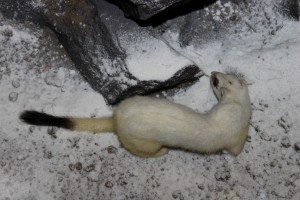 There are many mysteries in the world of wildlife that we do not understand and one of the most fascinating ones is about the stoat. Stoats are able to mesmerise their prey and good examples are their behaviour with rabbits and pheasants. Rabbits are a classic example when a stoat appears in a field where they are feeding. Once the stoat is seen, the rabbits will run for the shelter and safety of their burrows. However, the stoat has chosen one specific rabbit which it follows relentlessly. The rabbit may well be way out in the field with the others but for some unknown reason that is the one the stoat chooses above any of the others. Despite running past other rabbits that, to us, look the same the stoat seems to have a fixation on just one. What often happens is that in the end the rabbit seems mesmerised by the stoat and will actually give up, sit motionless and just squeal, as if waiting for the end. One quick bite to the neck and it is all over for the rabbit.
There are many mysteries in the world of wildlife that we do not understand and one of the most fascinating ones is about the stoat. Stoats are able to mesmerise their prey and good examples are their behaviour with rabbits and pheasants. Rabbits are a classic example when a stoat appears in a field where they are feeding. Once the stoat is seen, the rabbits will run for the shelter and safety of their burrows. However, the stoat has chosen one specific rabbit which it follows relentlessly. The rabbit may well be way out in the field with the others but for some unknown reason that is the one the stoat chooses above any of the others. Despite running past other rabbits that, to us, look the same the stoat seems to have a fixation on just one. What often happens is that in the end the rabbit seems mesmerised by the stoat and will actually give up, sit motionless and just squeal, as if waiting for the end. One quick bite to the neck and it is all over for the rabbit.
Another form of this is with birds such as cock pheasants and I once saw this down the Longman, in Inverness. The pheasant was strutting around a ride, as they do, when the stoat appeared. The pheasant stood its ground but then the mystery, as the stoat started running in ever decreasing circles around the bird that just stood mesmerised and then the stoat struck. A quick bite to the neck and the pheasant was dead. It definitely seems, to us anyway, that stoats have some way of mesmerizing such prey and this is not confined solely to rabbits and pheasants. We still have no idea how this behaviour works or has developed.
This is not the only enigma about the stoat, as the black tip to its tail seems to have an unusual use. The black tip is present whether the stoat is in its white winter coat, as in the photograph, or brown coat of summer, For us it means the difference between a stoat and a weasel as the latter has no black tip. As for the stoat, if it is about to be caught by a predator, such as a bird of prey, at the last moment it will flick its tail upwards. The black tip seems to momentarily attract the attention of the predator giving the stoat a moment to get away into cover. Some recorders have noted that the older the stoat the shorter the tail as predators have taken off the tip. Better to survive with a shorter tail than not survive at all!
At this time of the year any stoats in their white winter coat will gradually be moulting into their brown summer coats. This does not take place all over the coat at the same time and many variations in the brown/white pattern can be seen. Apart from persecution for its attacks on domestic and game birds, the stoat in its white” ermine” coat has another disadvantage. This white coat has been much prized in the past for fancy fur clothing and very many were trapped for this coat. Whilst the white coat may have developed to cope with snowy conditions, this winter has had the animal at a disadvantage. White stoats are very conspicuous without snow and much more readily seen by predators. Despite all the persistent persecution the stoat has still survived although its numbers are not the same anymore.
Tags: highland wildlife
